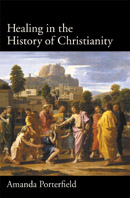Amanda Porterfield: Healing in the History of Christianity
 Amanda Porterfield, Healing in the History of Christianity (Oxford University Press, 2005), 218 pages, ISBN 0195157184.
Amanda Porterfield, Healing in the History of Christianity (Oxford University Press, 2005), 218 pages, ISBN 0195157184.
Healing has played an important role throughout the history of Christianity, according to Amanda Porterfield. In her new book, Healing in the History of Christianity, she traces the belief in healing back to the ministry of Christ and the teachings of the Old Testament. She shows how the practice of healing has been adapted and viewed by Christians in the early church, the Middle Ages and in the 21st century. Healing, she argues, is not only a central theme of Christianity; but it “has been a driving force in the construction of Christianity as an ongoing historical tradition” (4).
Porterfield is the author of a number of books on American religious history, including The Transformation of American Religion (Oxford, 2001). She is the Robert A. Spivey Professor of Religion at Florida State University, and a recent past president of the American Society of Church History. Porterfield also serves as co-editor of Church History: Studies in Christianity and Culture.
In Healing in the History of Christianity, Porterfield presents a scholarly discussion on healing in Christian history. The discussion is developed in five chapters that cover the following topics: Jesus: Exorcist and Healer; Healing in Early Christianity; Healing in Medieval Christianity; Healing in Early Modern Christianity; Healing in Western Christianity’s Global Expansion; Christianity and the Global Development of Scientific Medicine; and Christian Healing in the Shadow of Modern Technology and Science.
Porterfield begins her discussion with a focus on the ministry of Christ as presented in the Gospel of Mark. She depicts the time period and cultural events that were occurring at the time Mark’s Gospel was written, including exploring the link between healing and demonology. She also reports the various studies on “the historic Jesus,” and the role in which Christ is viewed as both an exorcist and healer in His ministry. In the chapters that follow, she reviews various studies on healing, and compares Christian healing with practices in other religions, suggesting, for instance, that Christians have borrowed some of their methods from other religions and cultures. She notes the similarities while showing how the practice of healing unites people in community. Many references are made to healing in the Catholic church. Furthermore, she explains how Christians have linked health and healing to sin and judgment.
Porterfield argues “that healing has persisted over time and across cultural spaces as a defining element of Christianity and a major contributor to Christianity’s endurance, expansion, and success” (19). It should be noted that she is a believer in healing. She writes: “I accept religious healing as a real biological phenomenon, although one prey to pious exaggeration” (19). Porterfield’s research offers different perspectives on healing in Christianity. She suggests that on one hand, Christians find comfort in cures accomplished in the name of Christ; and on the other hand, Christians find comfort in their ability to endure suffering, which is “part of a cosmic vision of redemption” (4).
While the book is thorough in its survey of Christian healing, it surprisingly omits some of the prominent names and events that are often discussed in Pentecostal revival and divine healing movements. In the final chapter, Porterfield includes a brief section on Aimee Semple McPherson, which is followed by a section on the growth of the Pentecostal movement. However, little else is provided, despite the many books, ministries, and scholarly research available.
Category: Church History, Pneuma Review, Spring 2011


